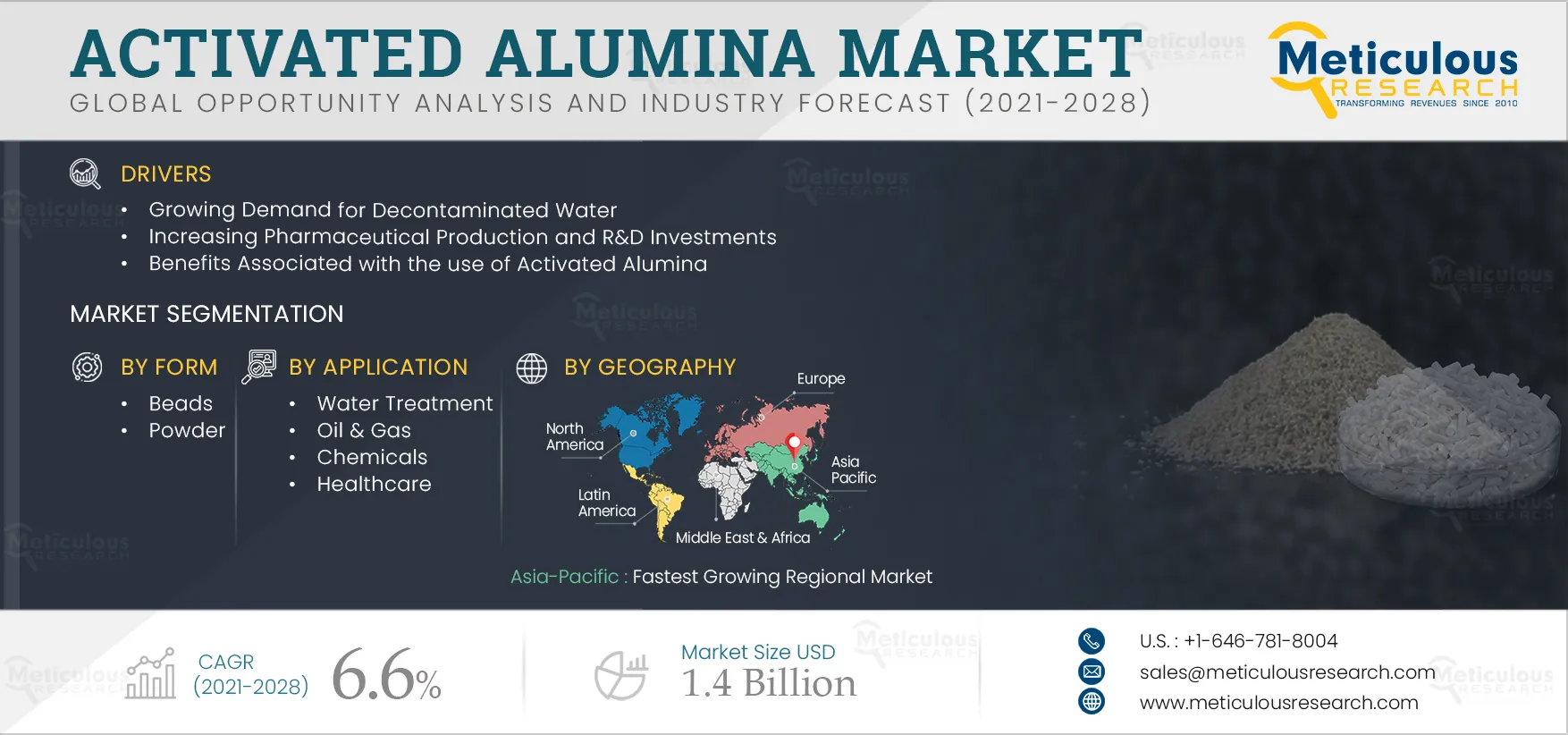Resources
About Us
Activated Alumina Market by Function (Adsorption, Catalysis, Desiccation), Form (Beads, Powder), and Application (Water Treatment, Oil & Gas, Chemicals, Healthcare) - Forecast to 2028
Report ID: MRCHM - 104518 Pages: 152 Sep-2021 Formats*: PDF Category: Chemicals and Materials Delivery: 2 to 4 Hours Download Free Sample ReportActivated alumina is a solid and porous form of aluminum oxide. It is manufactured by heating the compound and removing all moisture from it. Thus, its high surface area and porous consistency make it suitable for various industrial settings and processes. Growing demand for decontaminated water, increasing pharmaceutical production and R&D investments, and the benefits associated with activated alumina have positively impacted the activated alumina market.
As per the data from the International Federation of Pharmaceutical Manufacturers & Associations (IFPMA), in 2020, the COVID-19 pandemic resulted in a global economic collapse, with an estimated 3.5% contraction. While there are expectations that a robust economic recovery will occur in 2021, the global economy is still facing uncertainty. The recovery will depend heavily on success at controlling the spread of the pandemic, with the widespread deployment of effective vaccines playing a key role.
Activated alumina is widely used in desiccation, fluoride adsorption, catalysis, vacuum systems, food preservatives, removing trace metals and acidic impurities from organic streams, and de-fluoridation of drinking water. The excellent adsorption capabilities of activated alumina make it a popular industrial desiccant. The COVID-19 pandemic has deteriorated the global business environment, resulting in an uncertain outlook for the activated alumina market. The pandemic negatively impacted various industries by hampering the production and working capacities due to lockdowns and work restrictions, disrupting the global supply chain.

Click here to: Get Free Sample Pages of this Report
Companies are unable to predict the business impacts of the pandemic due to uncertainties related to the global spread of the virus, the severity of the infection, duration of the outbreak, and the length of the travel restrictions and business closures imposed by the governments of impacted countries. In addition, the pandemic has resulted in a widespread health crisis, negatively affecting financial markets across many countries. These factors have lowered the demand for activated alumina and impacted the operations and revenues of the companies operating in this market.
Additionally, it has been observed that countries across the world have started easing the lockdown restrictions due to the decreasing number of new infections and growing populations vaccinated against the coronavirus. Thus, it can be expected that operating capacities will rise across industries, which in turn will drive the demand for activated alumina globally. For instance, as per the data from the International Federation of Pharmaceutical Manufacturers & Associations (IFPMA), the biopharmaceuticals industry is undertaking extraordinary measures to deliver vaccines to patients. As of February 2021, 234 manufacturing and production deals had been signed exclusively for vaccines, indicating that the sector is striving to increase manufacturing capacities to ensure the availability of vaccines. Also, manufacturers are highly focused on increasing production.
Thus, the increasing manufacturing and R&D capacities across the pharmaceutical and biopharmaceutical sectors are expected to boost the demand for activated alumina in the coming years.
Based on function, the global activated alumina market is segmented into adsorption, desiccation, catalysis, and other functions. In 2021, the adsorption segment is expected to account for the largest share of the activated alumina market. This segment’s large share can be attributed to the increasing demand for decontaminated water across various industries, stringent regulatory and sustainability mandates, and the high focus on providing potable water to the large populations in developing countries.
Based on form, the global activated alumina market is segmented into beads and powder. In 2021, the beads segment is expected to account for a larger share of the activated alumina market. The segment’s large share can be attributed to the high demand for alumina beads (for water treatment) among developing countries and rising government initiatives to tackle water issues.
Activated alumina beads are highly porous and offer a high surface area-to-mass ratio, making them a highly effective absorbent for a wide range of applications. The beads are also used in oil & gas applications to dehydrate compressed air and gases such as liquid petroleum gas (LPG) and compressed natural gas (CNG).
Based on application, the global activated alumina market is segmented into water treatment, oil & gas, chemical, and healthcare. In 2021, the water treatment segment is expected to account for the largest share of the activated alumina market. The segment’s large share can be attributed to the increasing demand for decontaminated water among various industries, stringent regulatory and sustainability mandates, and high demand for water treatment in developing countries.
North America is estimated to command the largest share of the global activated alumina market in 2021, followed by Asia-Pacific, Europe, Latin America, and the Middle East & Africa. However, Asia-Pacific will be the fastest-growing regional market due to rising demand for decontaminated water, increasing pharmaceutical production, and government initiatives to promote hydrogen fuel in the region.
Key Players
The report includes a competitive landscape based on an extensive assessment of the key strategic developments adopted by leading market participants in the industry over the past four years. The key players profiled in the global activated alumina market report include BASF SE (Germany), Sumitomo Chemical Co., Ltd. (Japan), Honeywell International, Inc. (U.S.), J.M. Huber Corporation (U.S.), Porocel Corporation (U.S.), AGC Chemicals Pvt. Ltd. (India), Axens SA (France), Dynamic Adsorbents, Inc. (U.S.), Sorbead India (India), and Camfil Group (Sweden).
Activated Alumina Market, by Function
Activated Alumina Market, by Form
Activated Alumina Market, by Application
Activated Alumina Market, by Geography
Key questions answered in the report:
























Published Date: May-2024
Published Date: May-2024
Please enter your corporate email id here to view sample report.
Subscribe to get the latest industry updates